Turkey’s Christian Sites: Visiting 7 Churches From The Book Of Revelation
(TRAVEL) IZMIR, Turkey — The Book of Revelation, the final book in the New Testament, has long fueled theological imagination and debate. The prophetic and apocalyptic Christian writing has inspired diverse interpretations over the centuries. One thing not under dispute is the book’s strong historical ties to modern-day Turkey.
“Turkey’s significance is so often underestimated by Bible readers… who just don’t realize that so much of early church history occurred in what is today the country of Turkey,” said Todd Bolen, professor of biblical studies at The Master’s University in California and founder of BiblePlaces.com, an online resource designed to help people better understand the history, geography and archeology of biblical lands.
Revelation’s author identifies himself as Jesus’ “servant” John and says he received the prophetic visions recorded in the book while on the Aegean island of Patmos, just off the coast of Turkey. Longstanding church tradition holds that the author was the Apostle John, one of Jesus’ original 12 disciples, although some modern scholars believe the author could have been a different John.
In the beginning of Revelation, John issues letters of encouragement, admonition and warning that he says Jesus instructed him to write to seven church communities in the Roman province of Asia Minor, which is now Turkey. The churches were Ephesus, Smyrna, Pergamum, Thyatira, Sardis, Philadelphia and Laodicea.
“Those are major cities of the ancient world,” Bolen said.
Remnants of those cities can still be found on Turkey’s western coast, hundreds of miles across the country from where the devastating earthquake occurred in February. I visited all seven sites on a trip organized and paid for by the Turkiye Tourism Promotion and Development Agency.
After flying to Istanbul, clearing customs and walking through the huge new airport, I caught a short local flight to meet my group in Izmir, one of the oldest continuously inhabited cities in the world. All seven of the Revelation cities are easily accessible from Izmir, either by private cars and buses or public transportation. We visited them all in three days, and we traveled in the order they are mentioned in Revelation.
Ephesus (Revelation 2:1-7)
We spent our first full day touring in and around what is widely considered the archeological gem of Turkey: the ancient city of Ephesus. Ephesus was prominent in the Greco-Roman world because of its prime port location and its famous Temple of Artemis, which was designated one of the Seven Wonders of the Ancient World.
Ephesus also has a key place in Christian history. The city is mentioned several times in the New Testament. The Apostle Paul wrote the Book of Ephesians to Christians here. According to the Book of Acts, Paul lived and worked in Ephesus for nearly three years and also visited the city during his missionary journeys. Early Christian writers said the Apostle John came to live in Ephesus and led the growing new Christian churches until his death.
Turkish tour guide Servet Ugur specializes in tours of cultural and historical sites, including Turkey’s many Christian sites.
The ruins give a vivid sense of what the city looked like during New Testament times, from colonnaded streets, marketplaces and temples to bathhouses and even public toilets. The grounds are expansive, but our tour guide for the trip, Servet Ugur, told us only about 20% of the city has been excavated.
Although several temples have been reconstructed here, only a single column remains from the Temple of Artemis. Other pieces have been carried off to sites inside and outside Turkey. One of Ephesus’ best-known sites is the Library of Celsus, which once contained around 12,000 scrolls. The restored façade came into view as we walked downhill on the stone street that was surrounded by ruins of temples and monuments to emperors and deities, including Nike, the Greek goddess of victory.
For Christian tourists in particular, one of the most meaningful areas is the 24,000-seat theater, which the New Testament describes as the site of a dramatic riot led by a local silversmith, Demetrius. According to the story in Acts 19, members of the silversmiths’ guild were angry that Paul’s teachings about Jesus threatened their business of making silver figurines of Artemis. The riled-up mob came to the theater chanting, “Great is Artemis of the Ephesians” for several hours until local officials were able to restore calm. Today, many tourists take advantage of the well-preserved theater’s good acoustics by reading the biblical passage from the stage while others in the seats listen.
We also saw the ruins of the Church of Mary, which was built several centuries after the time of John and Paul. Christianity was still illegal when Revelation was written, so there were no actual church buildings. Communities of Christians often gathered for worship in people’s homes.
John’s letter to the Christians in Ephesus acknowledges their hardships and perseverance but chastises them for losing their initial love of their faith. He urges them to repent.
It’s possible to spend hours in Ephesus, and we did. However, we also briefly toured two other interesting sites in the area that illustrate some of the questions that still surround church traditions. One question is whether Jesus’ mother Mary spent the remainder of her life here rather than in Israel. In one Gospel account, while Jesus was dying on the cross, he instructed the Apostle John to take care of Mary. Because of this, some Christians over the centuries have claimed that John brought Mary with him when he came to Ephesus.
In the mountains just outside Ephesus, we visited a small house where some Christians, especially many Roman Catholics, believe Mary lived. The remains of the ancient house were discovered in 1891, when a priest followed details described in the visions of a German nun. A tiny church has been built at the location.
We ended our long day at the ruins of St. John’s Basilica, on a lovely vista above the modern city of Selcuk. The enormous sixth century basilica was built over the place that earlier Christians revered as the site where the Apostle John was buried. John’s tomb is marked by a marble slab. A model of what the basilica might have looked like in its heyday is encased in a glass-covered display.
The Bible doesn’t say what happened to John. Disputes continue over whether he died a natural death at an old age or was martyred. There’s even a tradition that claims he never died but rather was assumed into heaven. Servet told us there are no remains at the site today.
Smyrna (Revelation 2:8-11)
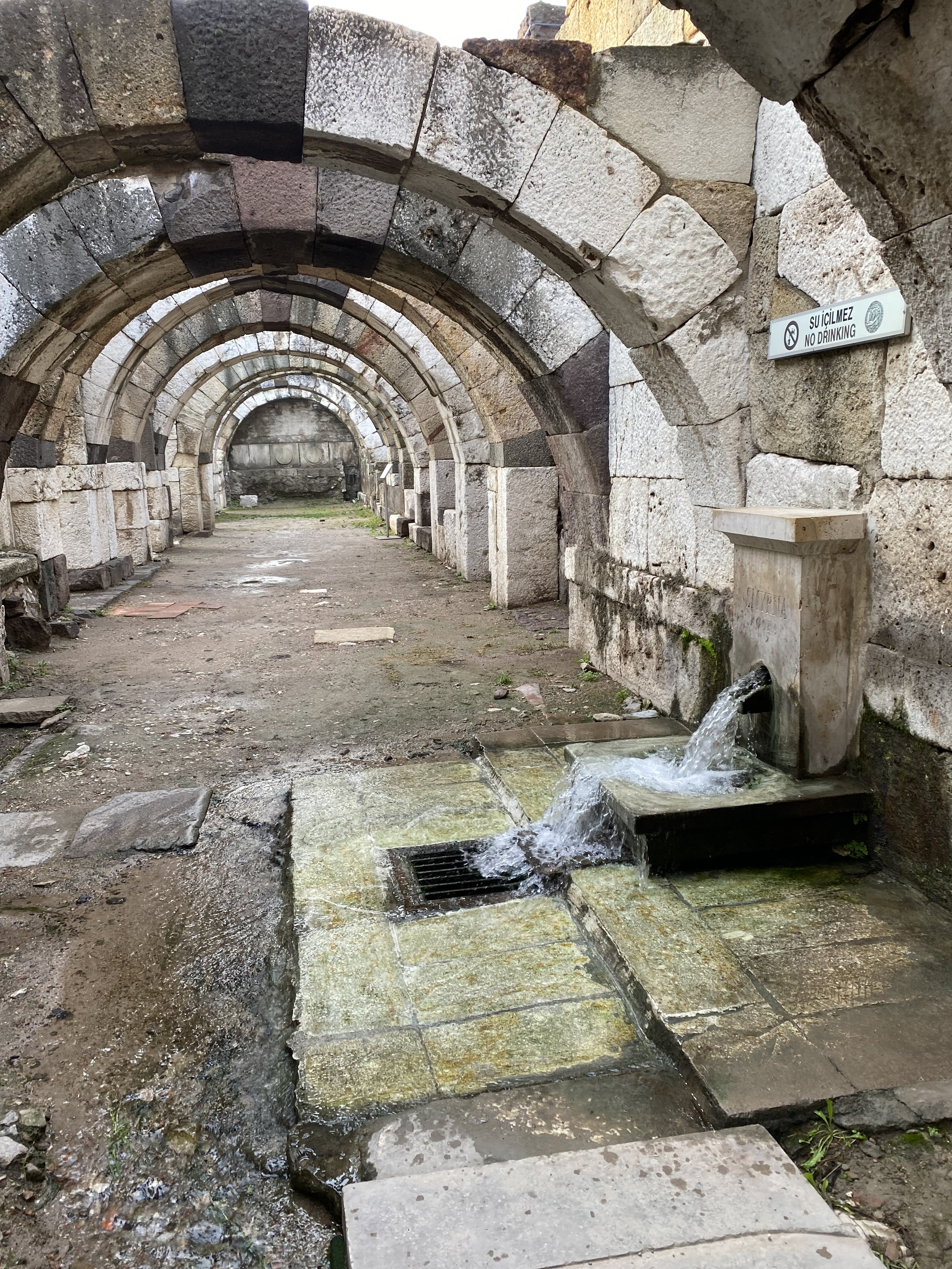
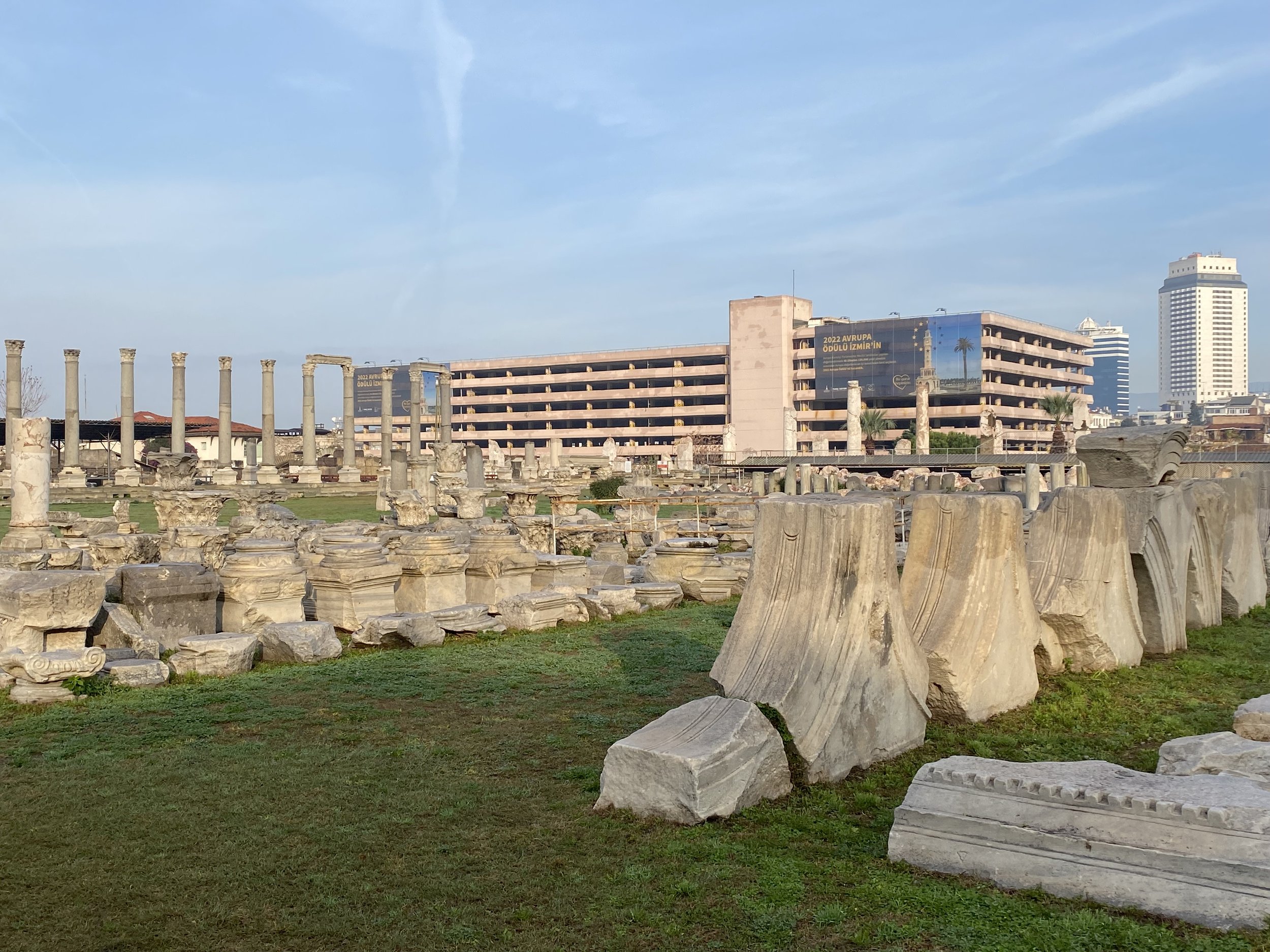

Our second day began at the site of ancient Smyrna, in a relatively small section of the present-day port city of Izmir. Because Izmir has been continuously inhabited for centuries, most remains from previous eras of the city have been buried under modern buildings. Significant excavation and restoration have occurred at the agora, or marketplace, which was the center of commercial, civic and cultural life.
Pieces of inscribed columns and sarcophagi surround the open-air museum. We also walked under the restored market arches and saw a working fountain. Elsewhere in the city, it’s possible to see ruins of cisterns and aqueducts from the Roman period.
In recent years, excavation at the agora area was allowed to expand after a primary school on the site burned down and wasn’t rebuilt. Archeologists believe there are important ruins under an adjacent parking garage as well, and they are hoping it may be torn down one day to allow for more exploration.
The Revelation message acknowledges that Christians in Smyrna had suffered poverty and slander, and it warns that even more persecution is ahead. The letter encourages them to be faithful, “even to the point of death.”
Just a few decades later, in A.D. 156, the bishop of Smyrna, Polycarp, was executed after he refused to proclaim that the caesar was lord. According to tradition, Polycarp had been a student of the Apostle John. Very early church documents say that the local magistrate ordered that Polycarp be burned at the stake. However, as the story goes, his body miraculously did not burn, so the executioner stabbed him to death.
After touring the open-air museum, we visited the still-functioning Roman Catholic Church of St. Polycarp. The large yellow church has a belltower and some graffiti painted on the surrounding walls. The current structure was built in 1898, after a fire destroyed the original church that dated to 1630.
Because we arrived outside normal visiting hours, Servet got on his cellphone and called the nun in charge. The sisters graciously let us in for a quick peek. The ornate interior includes a series of paintings of Polycarp’s story. Regular Masses are held here. The nuns gave us a brochure that listed five other churches in Izmir where Christian services take place.
Turkey, which is officially a secular nation, is roughly 99% Muslim today. Many areas no longer have an active Christian presence.
Pergamum (Revelation 2:12-18)
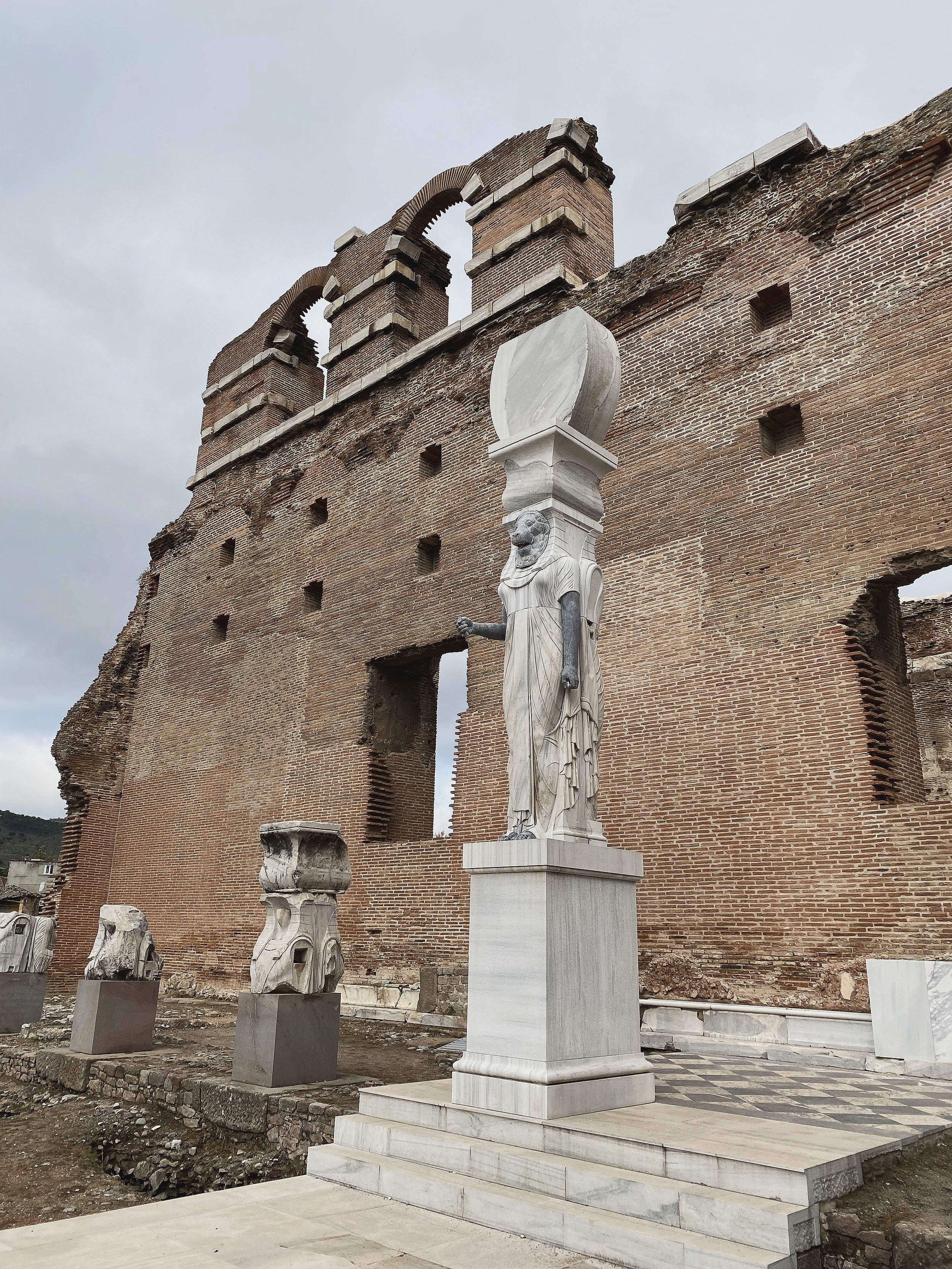
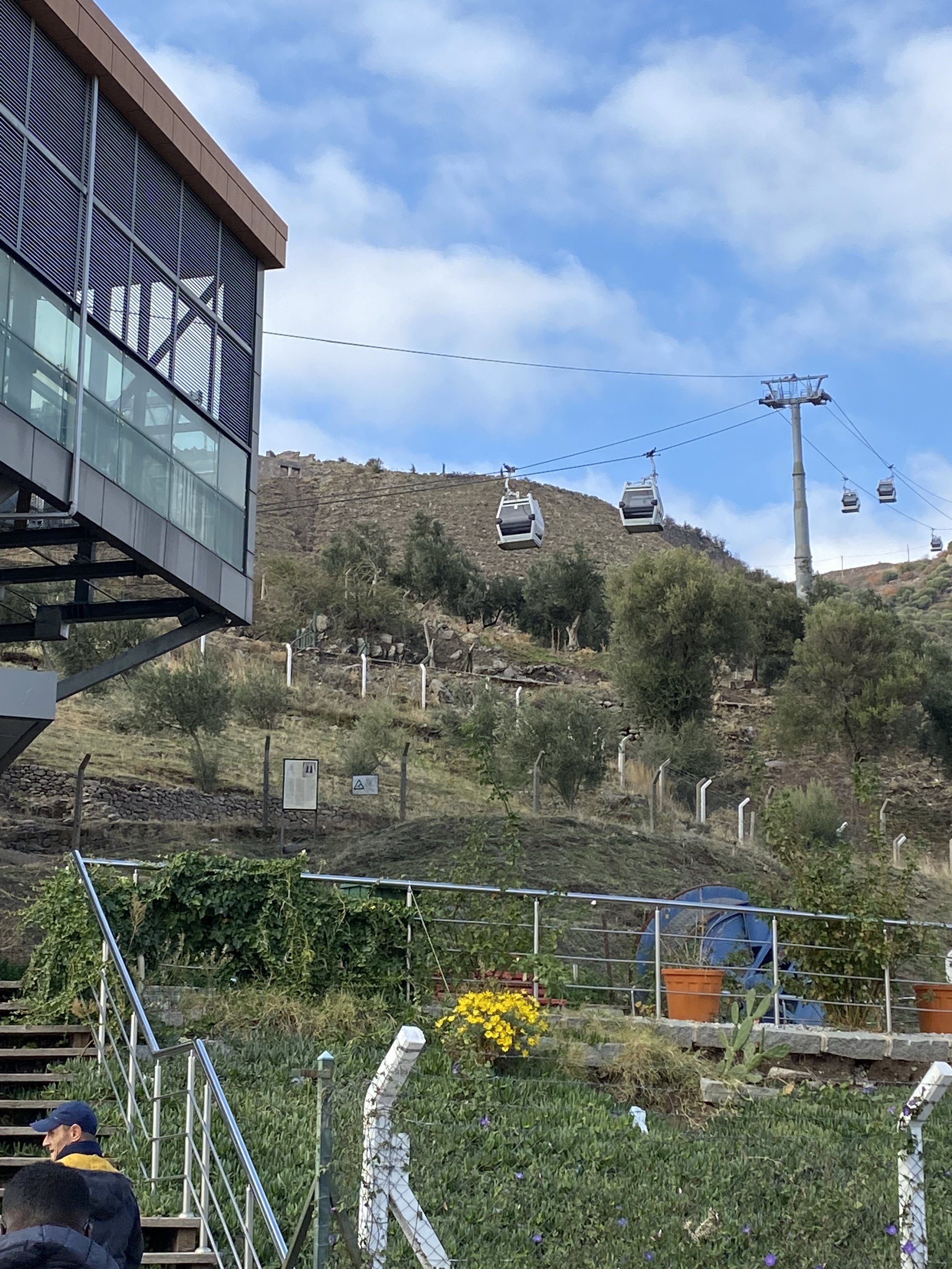
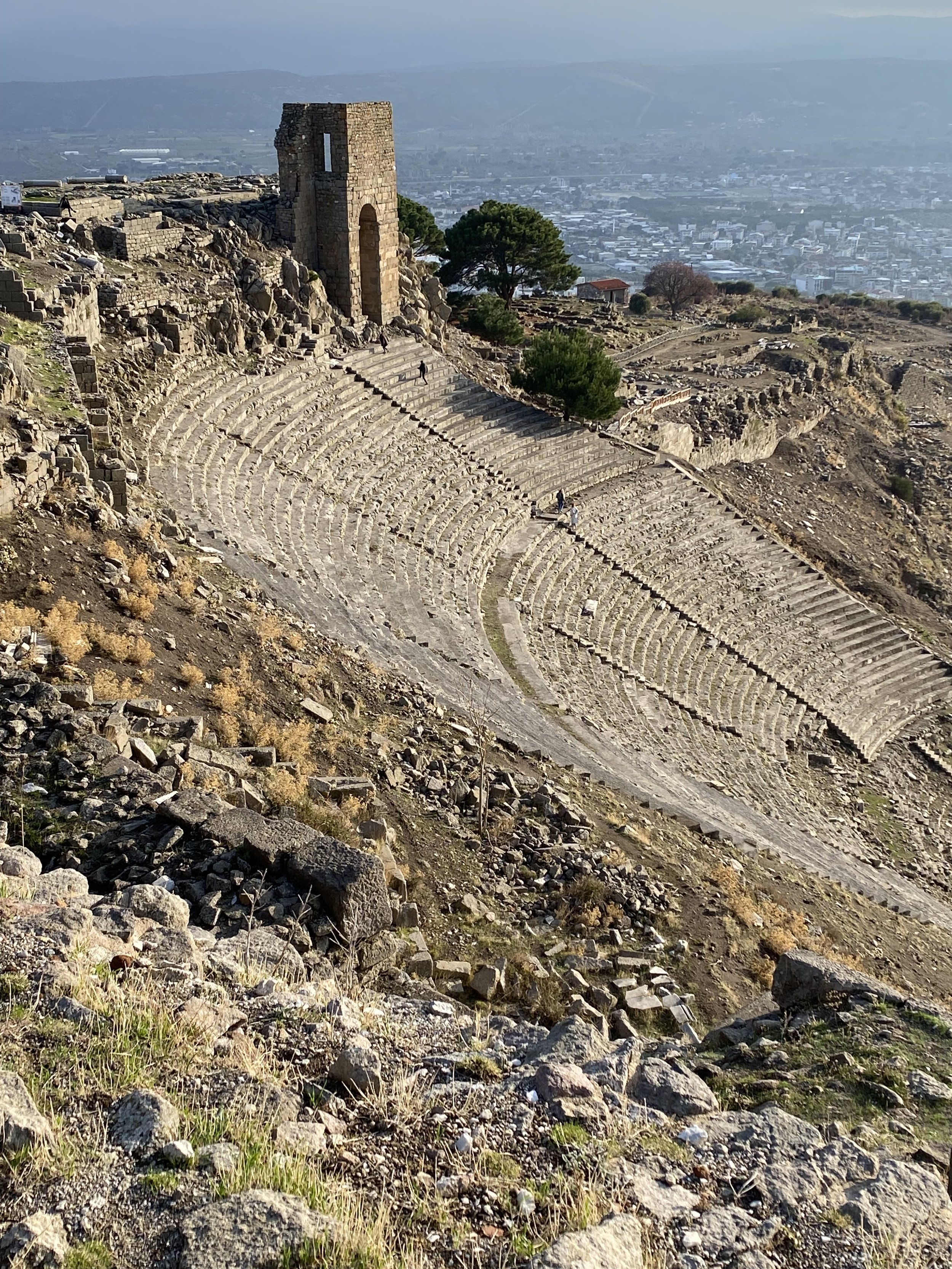

From Izmir, we drove to the important site of Pergamum, also known as Pergamon. The ruins here are extensive and divided into several areas. Just before lunch, we made a quick stop at the lower ruins, which are dominated by the enormous so-called Red Basilica. Servet told us it was likely originally built as a temple to Egyptian gods. And indeed, a restored Egyptian statue now stands in front of the building. Several hundred years after the Book of Revelation, the building was converted into a church.
We skipped the other lower and middle-area ruins in favor of heading to a restaurant in the modern city of Bergama for a tasty lunch of meat kebabs, tomato and cucumber salad, and a pumpkin dessert with sesame tahini. As we ate, Servet worried about the weather. As it turned out, the winds had died down enough for us to take the cable car up the side of the hill to visit the spectacular upper city acropolis. The cable car was installed in recent years for tourists who didn’t want to drive the sometimes-terrifying winding road up the steep hill.
Soon after we exited the cable car, we came to a shady fenced-in area of stone blocks, some in step formation. This was once the spot of a massive altar to the Greek god Zeus, where experts believe continuous sacrifices were burned. In the late 1800s, a German engineer led excavations in Pergamum and took pieces of the famous altar to Germany. The pieces were reconstructed and are now displayed in the Pergamon Museum in Berlin — much to the dismay of modern Turks who want to see the pieces returned. Some scholars believe the altar was the “throne of Satan” that John described in Revelation 2.
Above this area are several impressive ruins, including a temple to Athena, a temple to the Roman emperor Trajan, and a library that was once the second largest of the ancient world after the one in Alexandria, Egypt. Carved into the hillside is a 10,000-seat theater, the steepest one of its time.
In the second chapter of Revelation, the early Christians here are praised for not renouncing their faith after an early church leader, Antipas, was martyred in the city. However, the community is also criticized for allowing some of its members to adopt pagan practices and false doctrines.
Thyatira (Revelation 2:18-29)
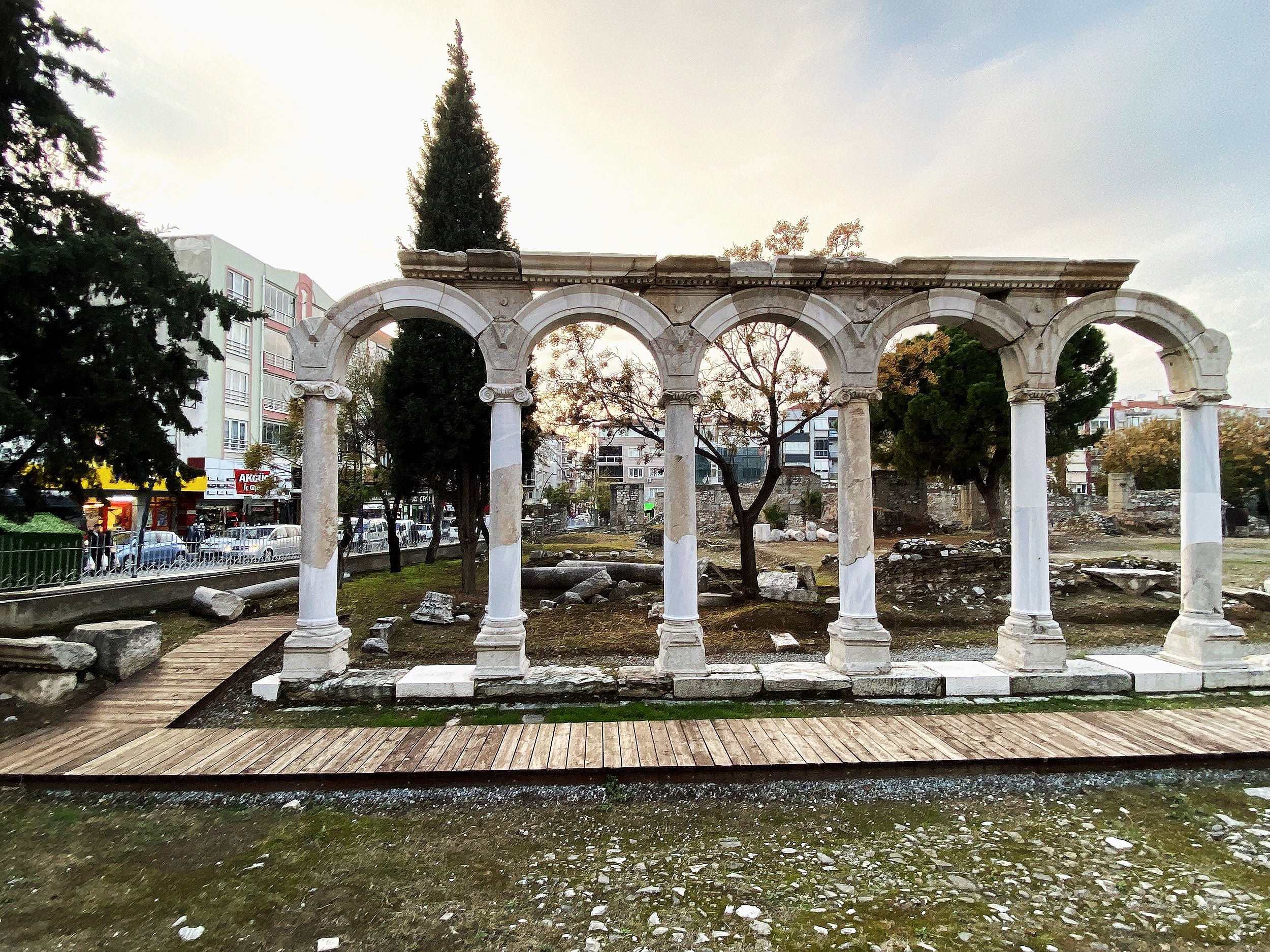
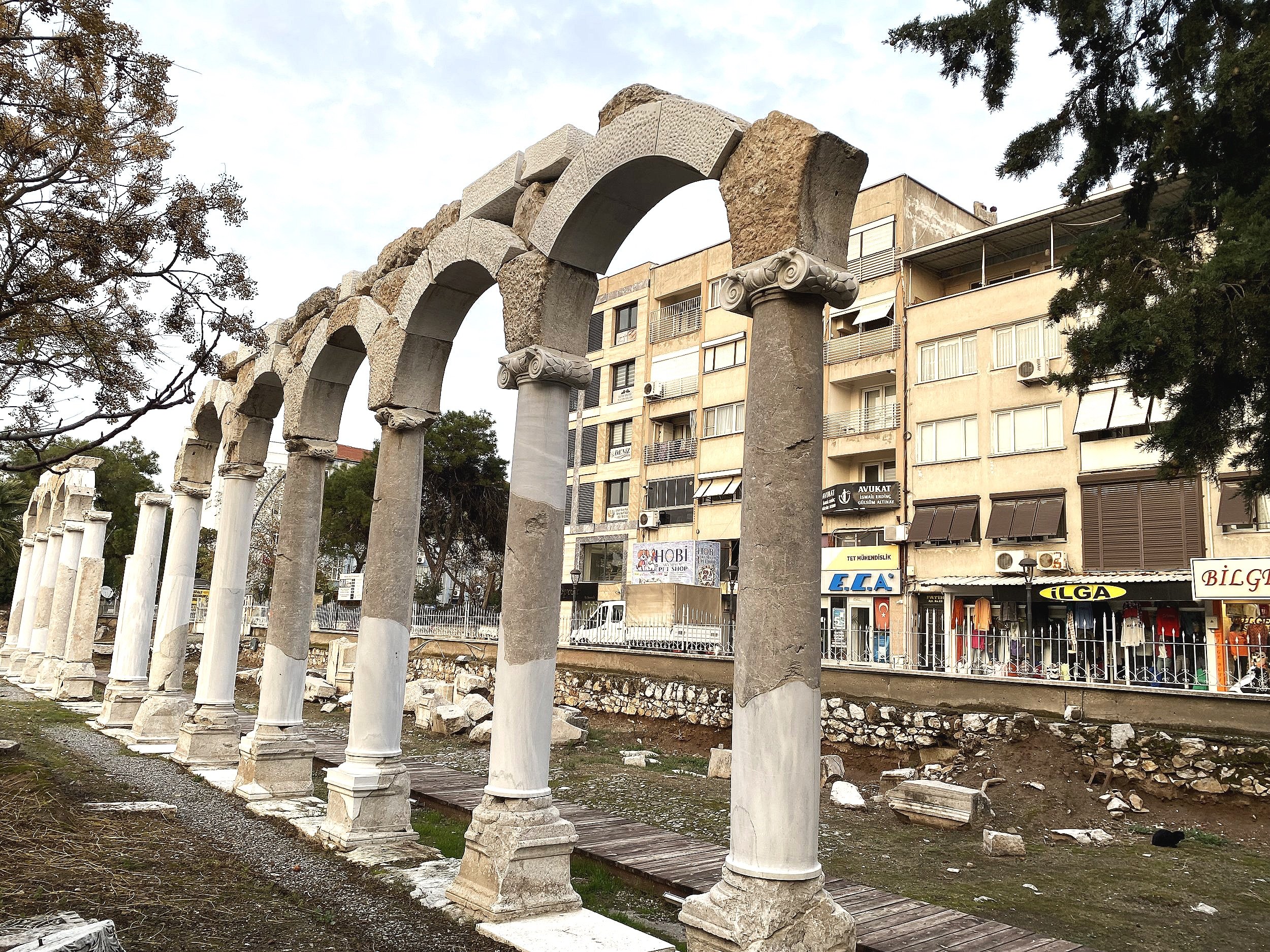
Our last stop of the long day was the nearby site of Thyatira, which is also mentioned in the New Testament as the hometown of Christian convert Lydia. She was a friend of Paul and a businesswoman who sold purple goods. This former military outpost was known across Asia Minor for its trade guilds, including one for dyers who used a famous deep crimson-purple dye.
Today, this is the bustling city of Akhisar. In contrast to the other sites we had visited, there are few visible remains of the ancient world. In the city center, a fenced-off park contains a small section of a second century colonnaded street, the walls of a later administrative building and other crumbling ruins. It’s a strange juxtaposition to see the ancient stones surrounded by utilitarian apartment buildings, modern retail shops and traffic-congested streets.
In Revelation, the Christians here are commended for their good deeds and perseverance but warned against tolerating deceptive teachings, pagan practices and sexual immorality.
Sardis (Revelation 3:1-6)
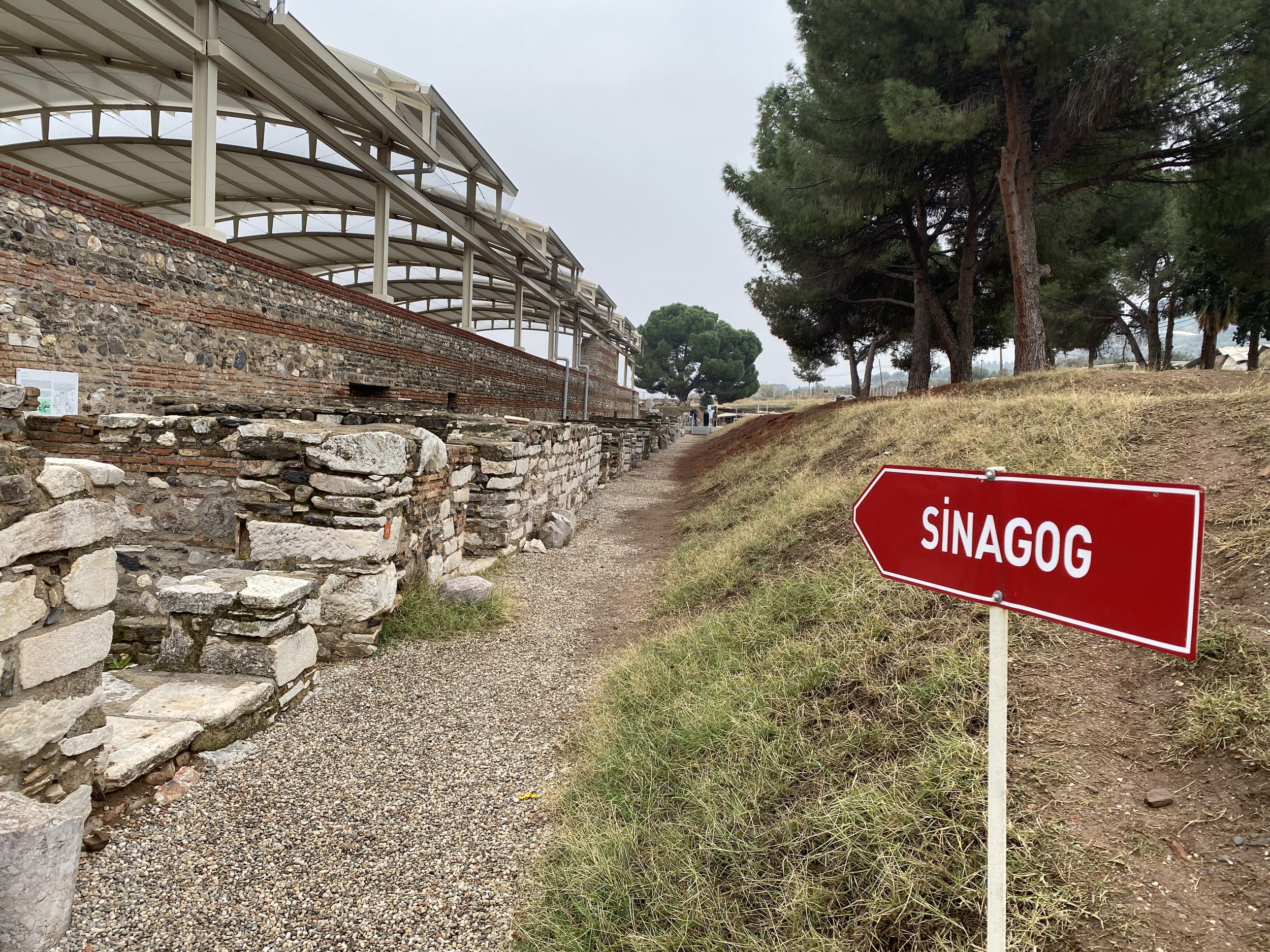
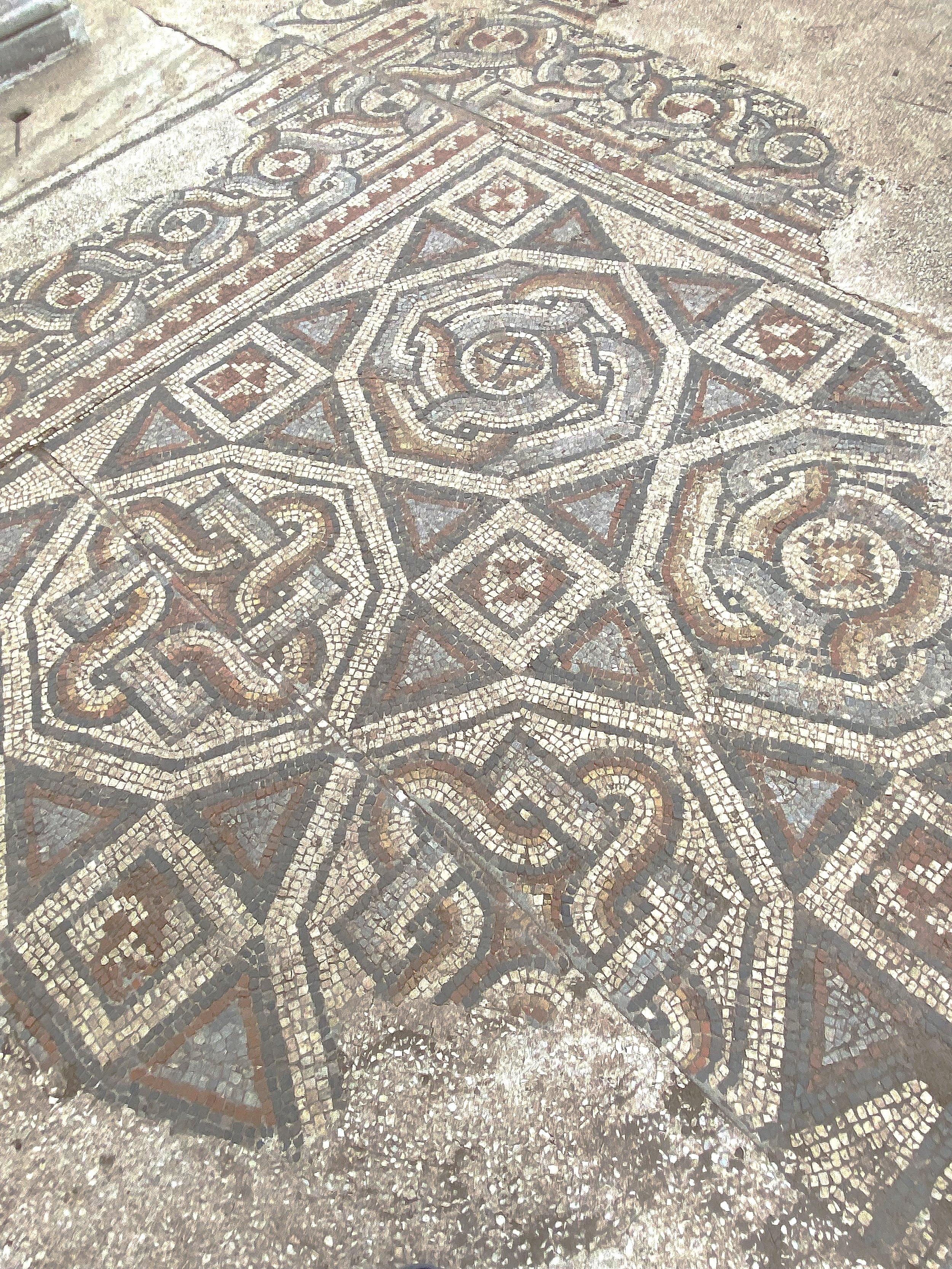
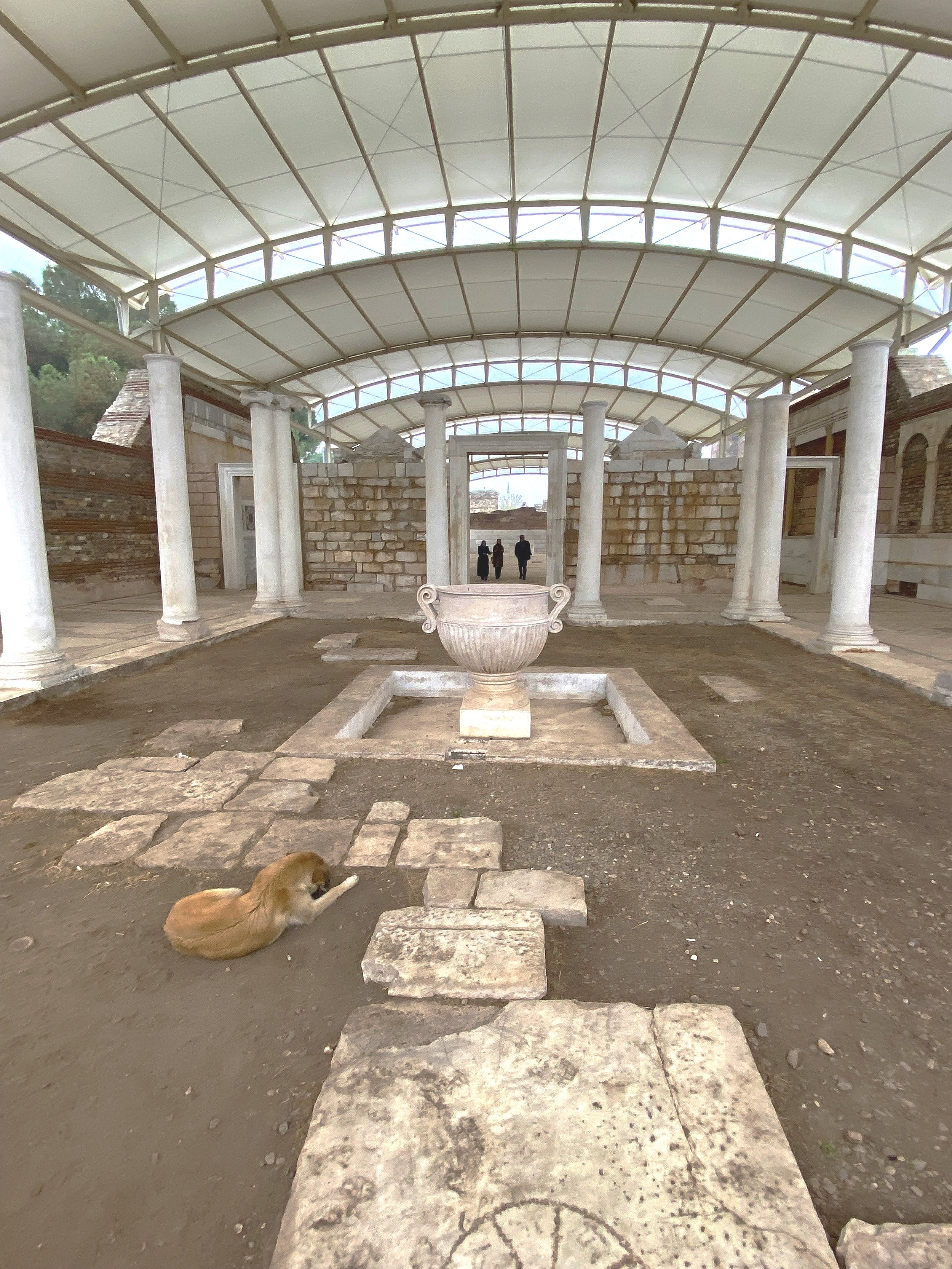
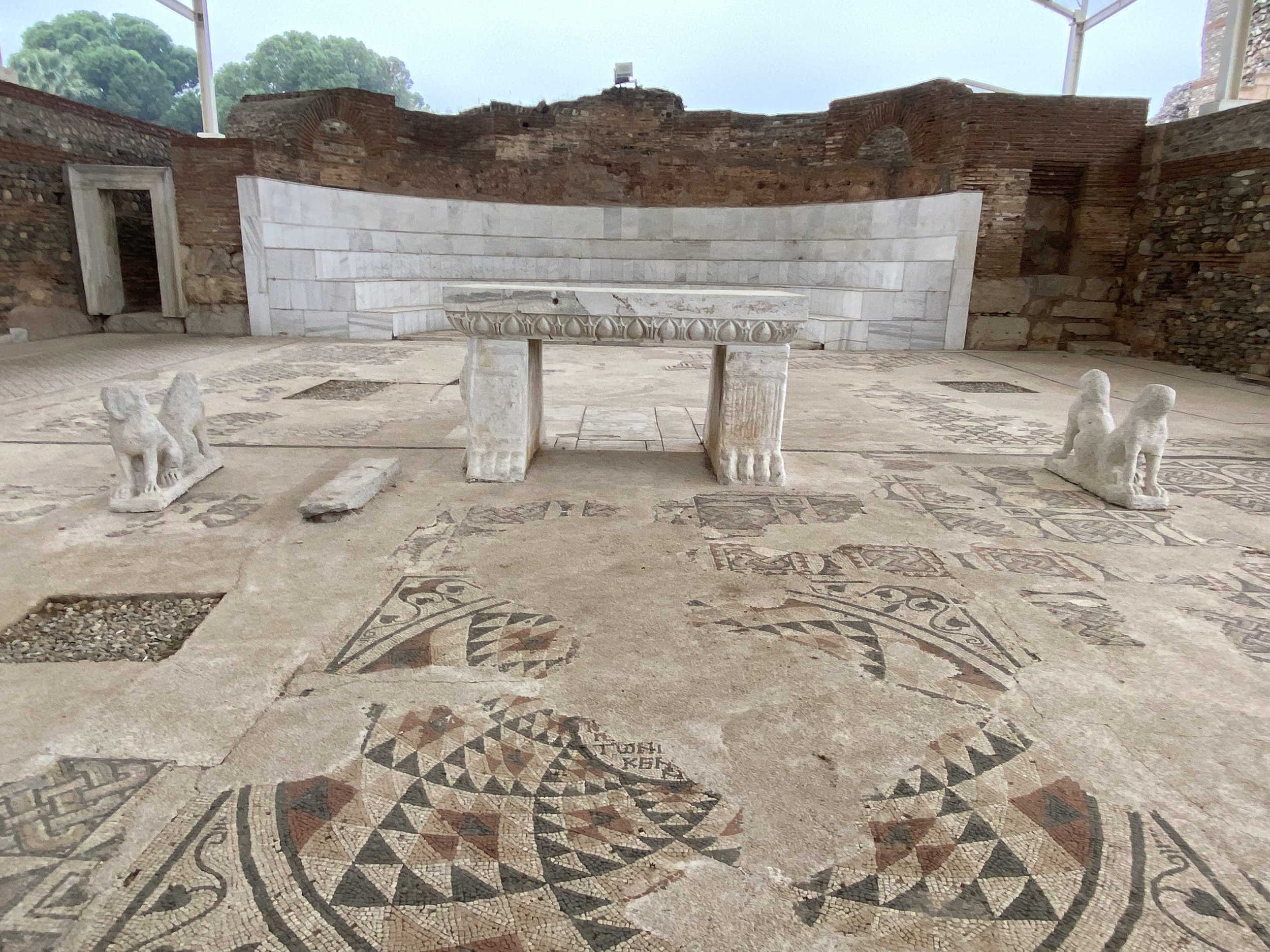
Our third, and final, day of visiting the church sites began in Sardis, a legendary city settled sometime before 1400 B.C. Wealthy King Croesus, namesake of the phrase “as rich as Croesus,” ruled here in the sixth century BC.
We entered at the main district of the ancient city, where a new tourist center was being constructed. We arrived early in the morning and had the place to ourselves, except for several wild dogs that followed us along the path as we passed Byzantine-era shops dating to around A.D. 400. Some Christian shops were marked with carved crosses. Scholars believe at least six of the 27 shops were owned by Jews.
We followed the path to a reconstructed synagogue, considered the oldest and largest outside of Israel. The synagogue was discovered in the early 1960s by a team of archeologists from Harvard and Cornell Universities. Excavation and restoration work was partially funded by American Jews.
The synagogue has two rooms: a forecourt with a large fountain for ceremonial washing before prayers and the main assembly hall, which could hold up to 1,000 people. In the main hall are two shrines that likely housed Torah scrolls and a marble table with eagle carvings and lion statues placed next to it. A key feature in both rooms is remnants of stunning mosaic floors. A new roof was constructed last year to protect the fragile mosaics from the elements.
The synagogue is part of a reconstructed bath and gymnasium complex with an elaborate marble court. The complex would have been a key part of Sardis social life during the Roman period. Scholars say the prominent location of the synagogue shows the influence and wealth of Sardis’ Jewish population. In some Asia Minor cities, Christianity grew within the Jewish community. In other areas, they were two distinct groups, fraught with tensions.
Sardis also features a well-known Ionic temple dedicated to the goddess Artemis. Construction on the temple began in the fourth century B.C. Nearby are the ruins of a small Christian church whose inner chapel dates to the fourth century A.D.
Revelation’s message to the Christians here acknowledges their past reputation but warns that their deeds are unfinished. The letter admonishes them to wake up before it’s too late.
Philadelphia (Revelation 3:7-13)
Ruins of a large Byzantine church in the old city of Philadelphia, with a mosque in the background.
Philadelphia, now the modern city of Alasehir, is just 30 miles southeast of Sardis. There is even less to see here than at Thyatira. Some crumbling ruins from Roman-era Philadelphia can be found in an acropolis overlooking the city, although we didn’t visit it. We did make a quick stop at a tiny park in downtown Alasehir, across from a mosque. There we saw the massive brick remains of an archway from a church that was built several hundred years after Revelation was written. Deteriorated frescoes are barely visible near the top of the arches. Inscribed stones and sarcophagi are scattered around the site. The Turkish caretaker proudly showed us one panel carved in the Armenian language.
This church was built during a time when Christianity was legalized and thriving in the region. But centuries earlier, Christians here had suffered severe persecution under Roman leaders. According to early church documents, eleven Christians from Philadelphia were martyred in Smyrna along with Polycarp in 156 AD. In Revelation, Philadelphia’s Christians are praised for their patient endurance. They are encouraged to hold on “so that no one will take your crown.”
Standing in the small park, I couldn’t help but wonder what pieces of history may still be buried underneath the homes and businesses around me. Bolen believes the same questions hold true for the still-active cities of Smyrna and Thyatira.
“Who knows what they would find if they could dig even just a block north,” he says.
Laodicea (Revelation 3:14-22)
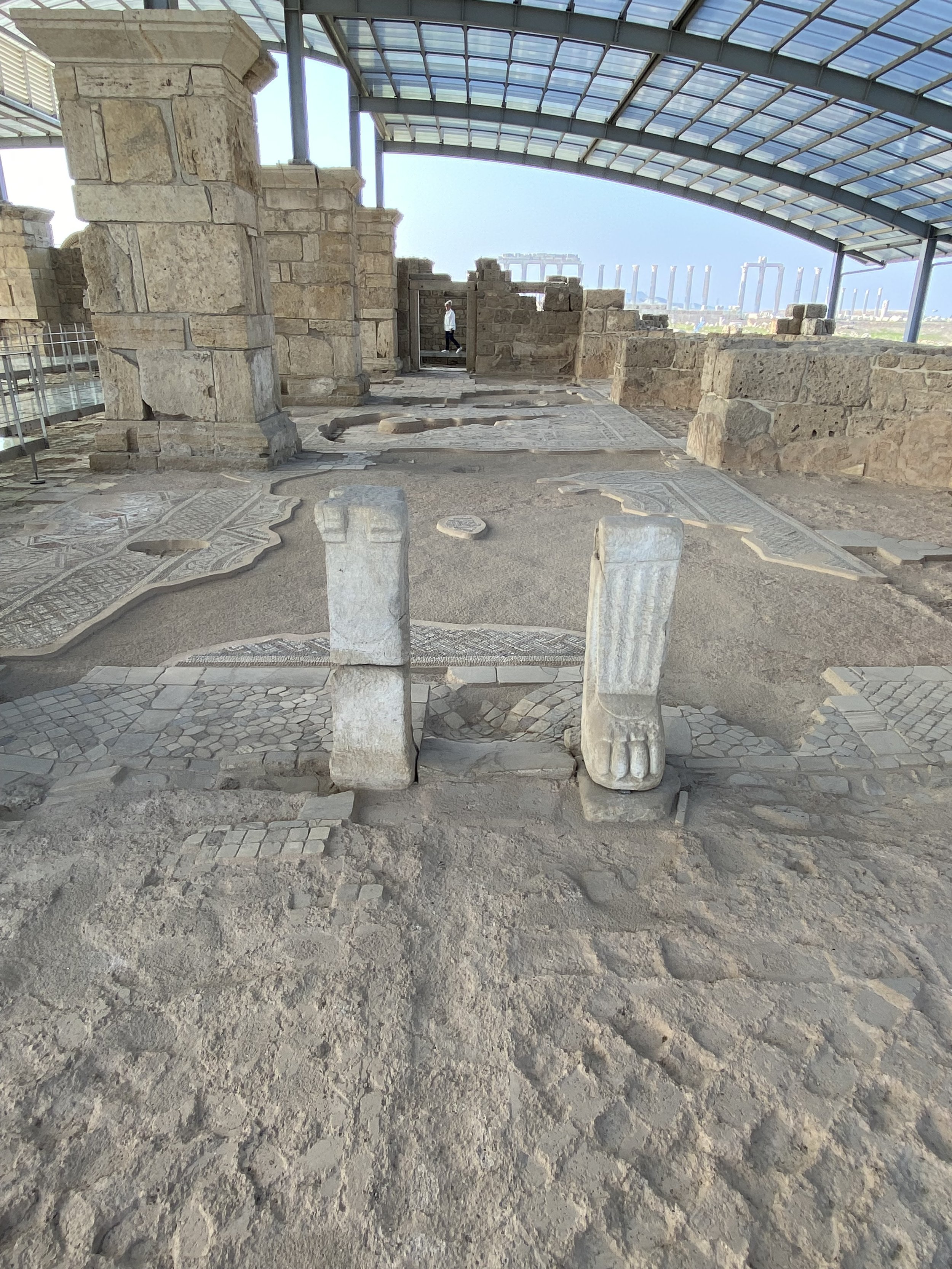
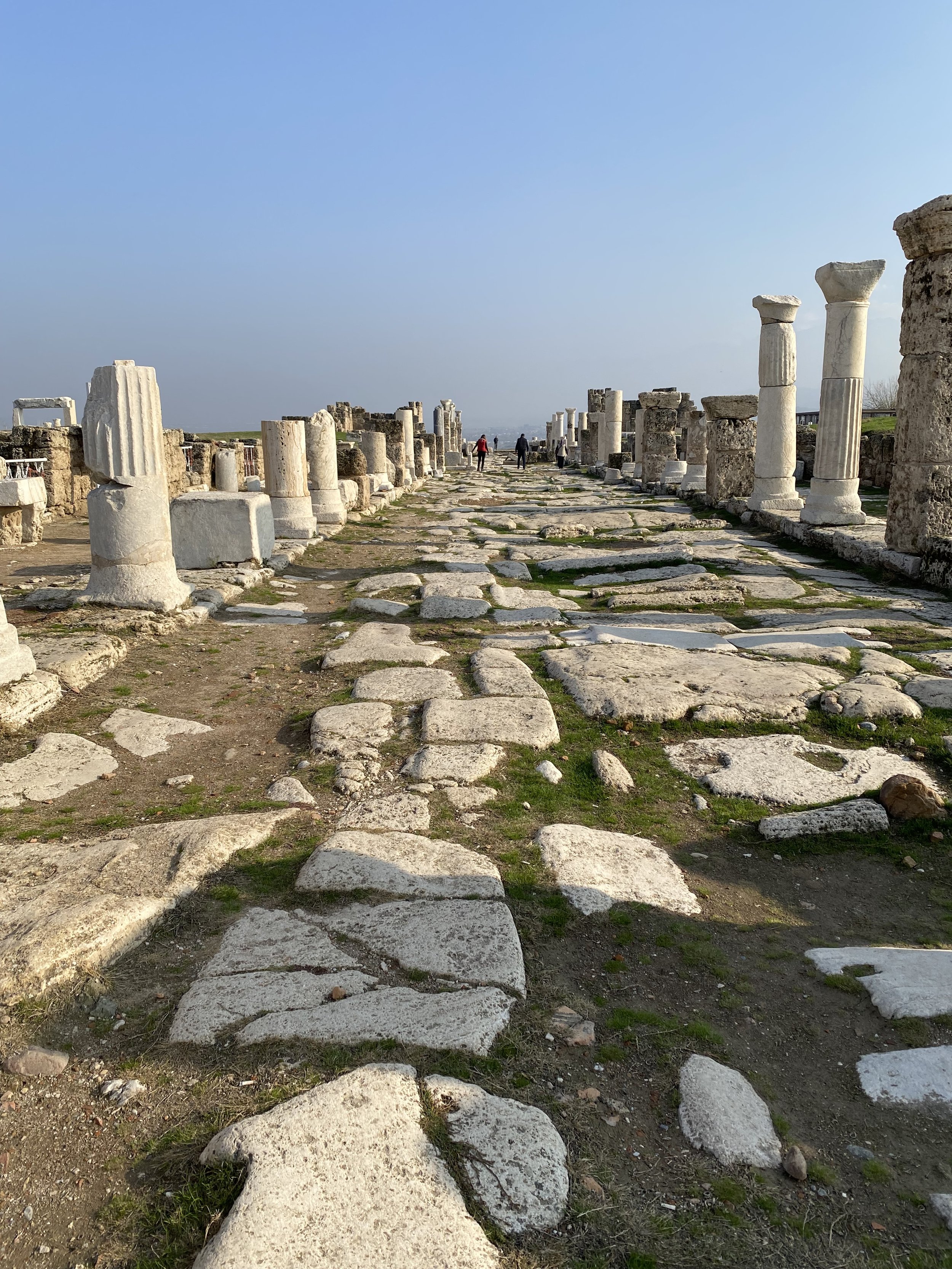
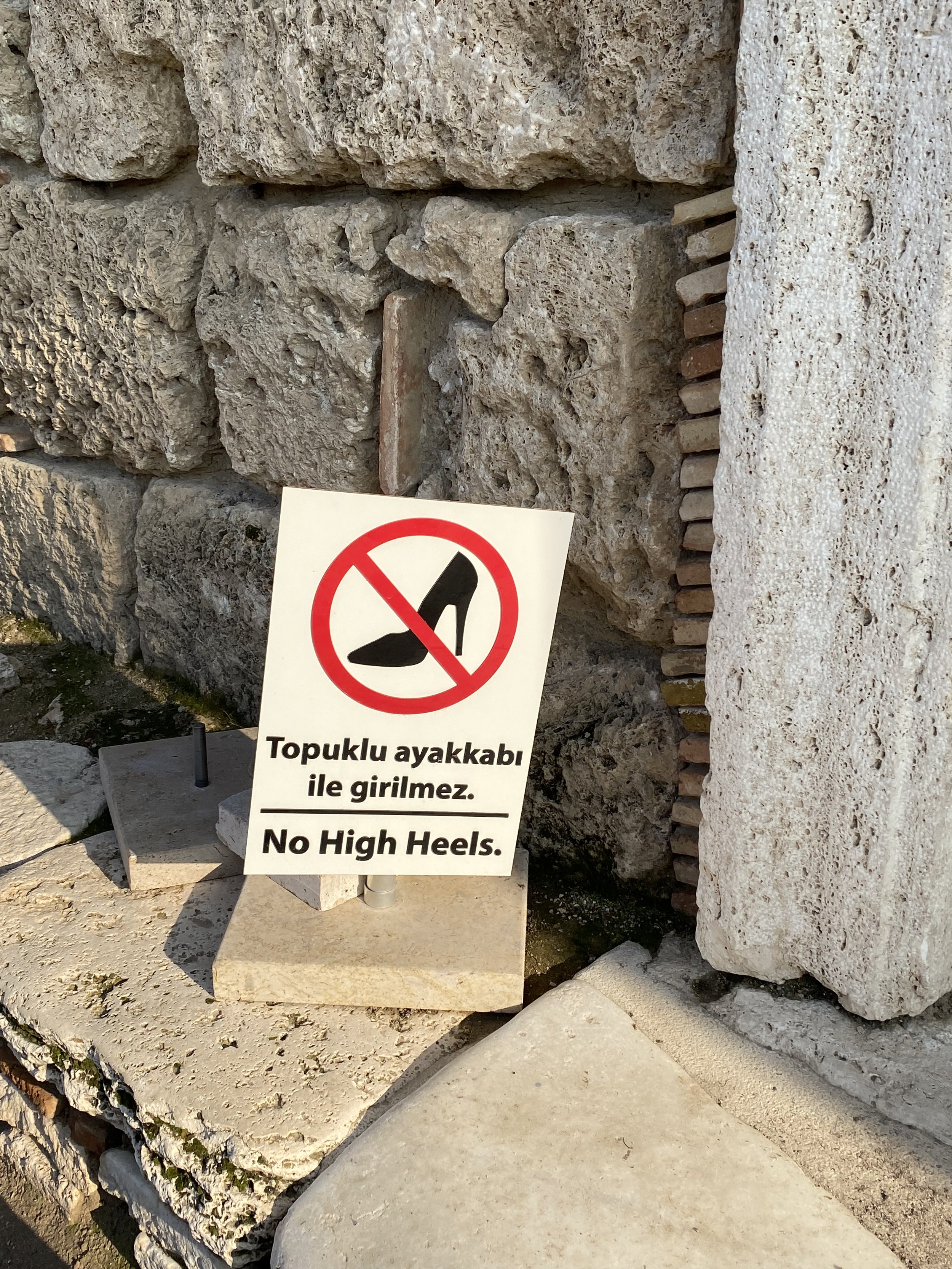
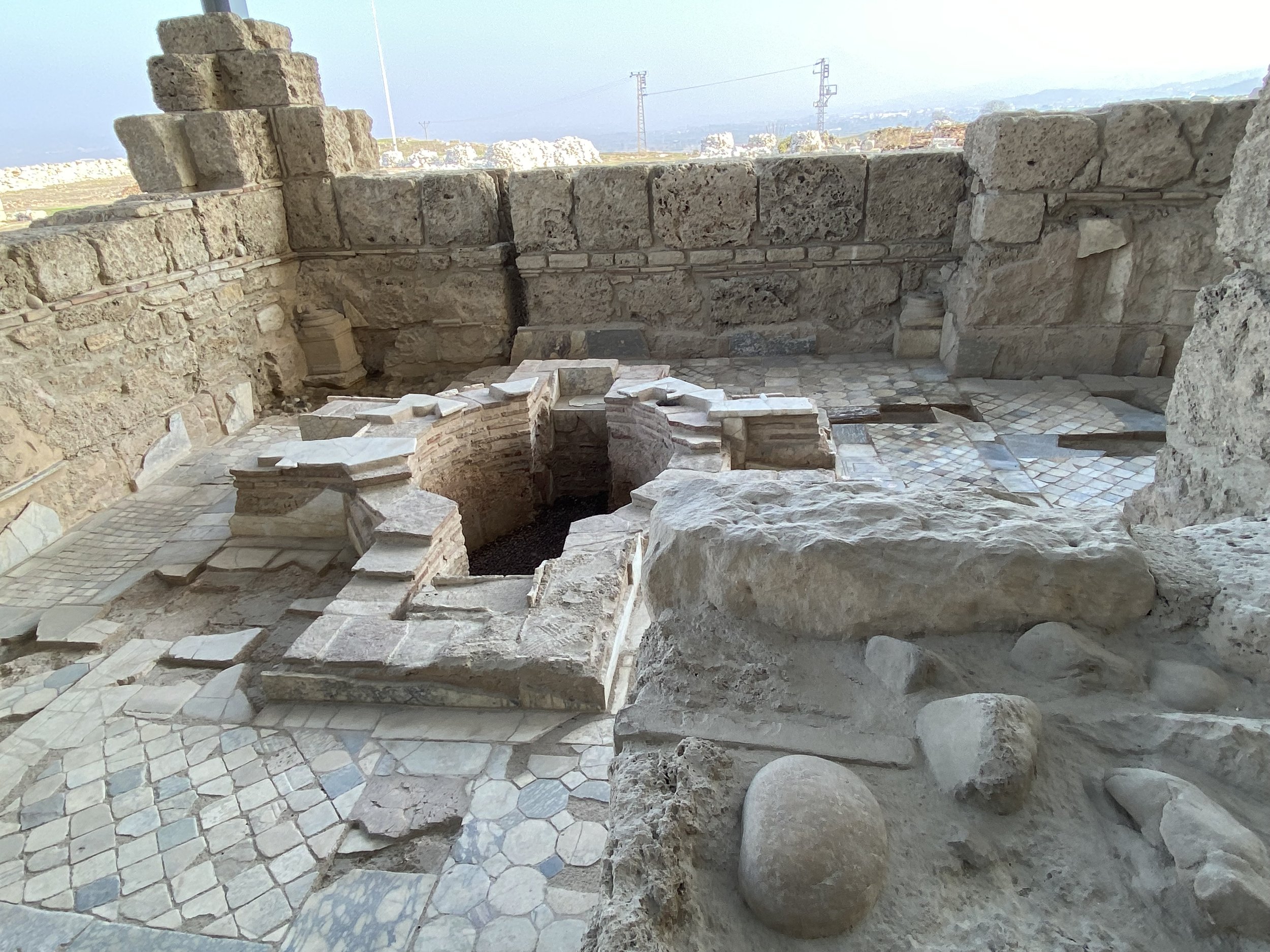
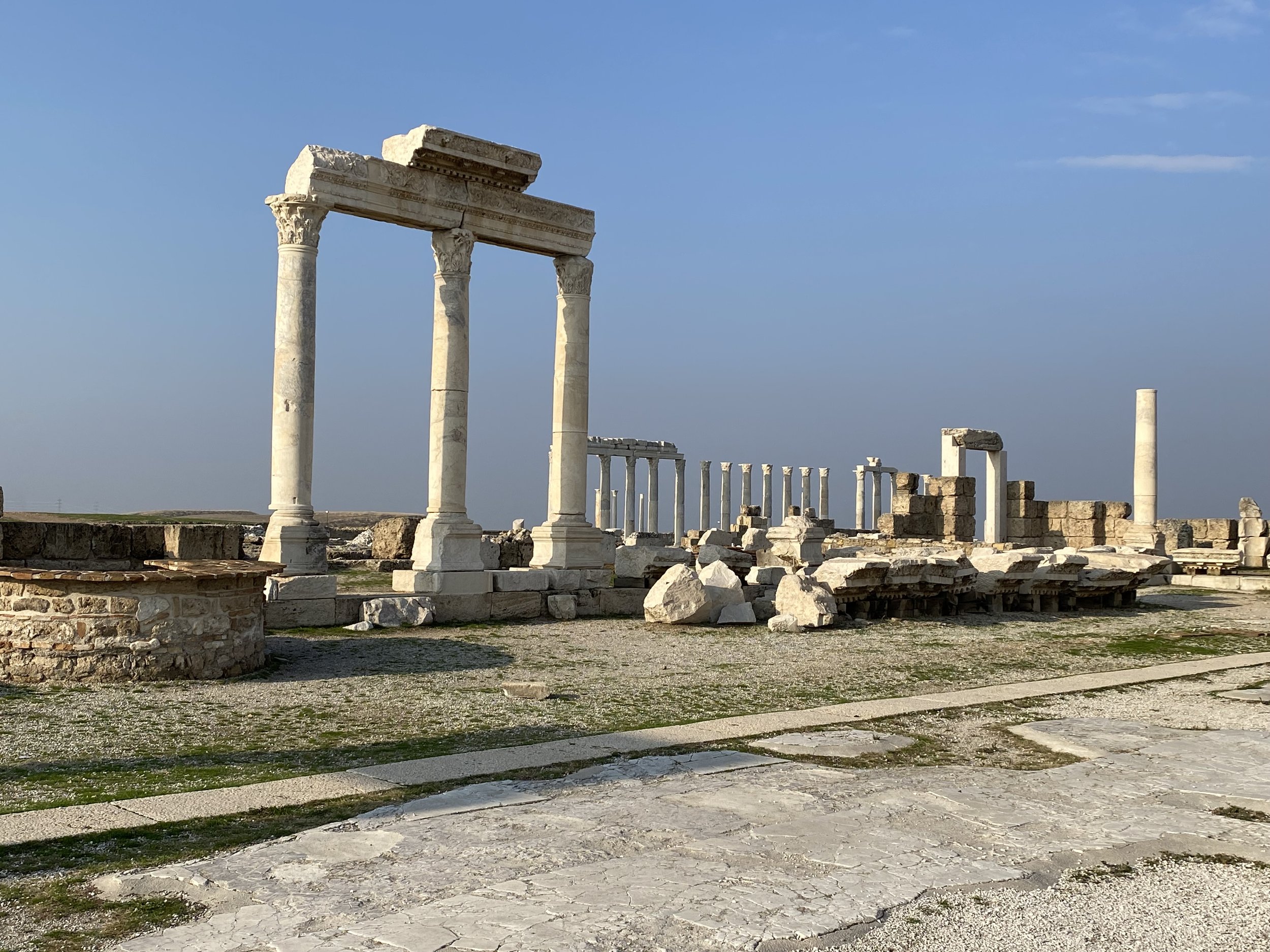
The last stop of the day, and the seventh church on our list, was Laodicea, which was a stark contrast to Philadelphia. The sprawling Laodicea site is spread across a hilltop outside the modern city of Denizli. In the New Testament Book of Colossians, Paul instructs that his letter to the Christians in Colossae also be read in Laodicea, which was nearby. After Christianity was legalized in A.D. 313, Laodicea became an important Asia Minor center for the new religion. It was abandoned after an earthquake in the seventh century A.D.
I visited this site more than 20 years ago and found the once-wealthy ancient city a desolate wasteland, with fragments of stone blocks and broken columns. Pieces of a crumbling theater appeared to be falling down the hill. The place seemed to illustrate fulfillment of the warning in Revelation 3, where Jesus famously told Laodicean Christians that because they were lukewarm — neither hot nor cold — he would spit them out of his mouth.
What I saw on this trip was vastly different. Excavations of the site began in 2003, and the massive work is ongoing. Archeologists have unearthed and are restoring numerous buildings and monuments that show Laodicea’s power and wealth, including two theaters, temples to Roman gods and imperial leaders, a stadium, four bath complexes, a huge water distribution system, marketplaces, houses and colonnaded streets.
Nearly two dozen chapels and churches have been discovered here as well, some in residences, which reflect the early Christian practice of meeting in house churches. The most important church is an enormous basilica that dates from the fourth through the seventh centuries. So far, archeologists have discovered an altar, a baptistry and several large sections of mosaic floors. A new modern roof has been constructed to protect the mosaics from deteriorating further.
“Laodicea is the example that however long it’s been (since you’ve visited), it’s going to look different in some ways” because of all the excavating work that still being done, Bolen said.
Turkey has submitted Laodicea for recognition as a UNESCO world heritage site, noting in its application that Laodicea “has more buildings and bigger buildings than the Athens Acropolis.”
The seven Revelation church sites are just a small glimpse of Turkey’s early Christian history. Scholars believe as many as two-thirds of the 27 books in the New Testament were written to or from what is now Turkey. Several early ecumenical church councils met in Asia Minor to hammer out foundational Christian beliefs. The cities here were associated with many New Testament and early church leaders, including St. Nicholas, the fourth century bishop who was the inspiration for Santa Claus.
READ: In Search Of The Real St. Nicholas’ Deep Roots In Turkey
“After the Gospels, which describe the earthly life and ministry of Jesus in Israel, Turkey takes center stage in New Testament and church history,” writes scholar Mark Wilson, author of Biblical Turkey: A Guide to the Jewish and Christian Sites of Asia Minor.
Turkish tourism officials are frustrated that more Christians are not coming to Turkey to explore their faith heritage. Servet acknowledged that many Western Christians have what he believes is an unfairly negative opinion about Turkey. However, he said his country wants to promote its Christian heritage, even if this was not always the case.
“Lately, a very, very serious amount of money is spared for the restorations of the historical sites, excavating the ancient cities,” he said. “We understand its value.”
Servet has been a tour guide for more than 20 years and specializes in cultural tours, including tours of the Christian sites. “This is a very important geography,” he told me. “The Christians who endured all the oppression and persecution from the Romans, if they had given up, then I guess Christianity would not have had the chance to survive.”
Kim Lawton is president of Kim Lawton Media, a video production and media consulting company near Washington, D.C. She is the former managing editor of the highly-acclaimed PBS series "Religion & Ethics NewsWeekly." She traveled to Turkey on a trip sponsored by the TurkeY Tourism Promotion and Development Agency.


